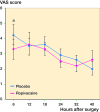No effect of double nerve block of the lateral cutaneous nerve and subcostal nerves in total hip arthroplasty
- PMID: 29493328
- PMCID: PMC6055781
- DOI: 10.1080/17453674.2018.1437951
No effect of double nerve block of the lateral cutaneous nerve and subcostal nerves in total hip arthroplasty
Abstract
Background and purpose - The use of local infiltration anesthesia (LIA) has become one of the cornerstones of rapid recovery protocols in total knee arthroplasty patients during the past decade. In total hip arthroplasty (THR), however, the study results are more variable and LIA has therefore not yet been generally accepted. There is no consensus on which structure should be infiltrated and the cutaneous nerves are generally neglected. Hence, we hypothesized a pain-reducing effect of specifically blocking these nerves. Patients and methods - We performed a single-center randomized placebo-controlled trial in 162 subjects to evaluate the infiltration of the lateral cutaneous femoral and subcostal nerve with ropivacaine in patients undergoing total hip arthroplasty via a straight lateral approach. The primary endpoint was pain at rest after 24 hours. Patients were followed up to 6 weeks postoperatively. Results - After correction for multiple testing, no statistically significant differences in pain scores were found between the ropivacaine compared with the placebo group after surgery. In addition, no differences were observed in the use of escape pain medication, complications, and the length of hospital stay. Interpretation - We found no clinically meaningful differences in pain scores between placebo and ropivacaine patients in the postoperative period after THA performed via a straight lateral approach under spinal anesthesia and a multimodal pain regimen. Moreover, our primary endpoint, pain reduction after 24 hours, was not met. Further research should focus on the composition and volume of the LIA suspension, the optimal localization of the infiltration, and should be evaluated for every surgical approach separately.
Figures
References
-
- Andersen L O, Kehlet H.. Analgesic efficacy of local infiltration analgesia in hip and knee arthroplasty: a systematic review. Br J Anaesth 2014; 113: 360–74. - PubMed
-
- Andersen K, Pfeiffer-Jensen M, Haraldsted V, Søballe Kjeld.. Reduced hospital stay and narcotic consumption, and improved mobilization with local and intraarticular infiltration after hip arthroplasty. Acta Orthop 2007a; 78: 180. - PubMed
-
- Andersen L J, Poulsen T, Krogh B, Nielsen T.. Postoperative analgesia in total hip arthroplasty: a randomized double-blinded, placebo-controlled study on peroperative and postoperative ropivacaine, ketorolac, and adrenaline wound infiltration. Acta Orthop 2007b; 78: 187–92. - PubMed
-
- Andersen L Ø, Husted H, Otte K S, Kristensen B B, Kehlet H.. High-volume infiltration analgesia in total knee arthroplasty: a randomized, double-blind, placebo-controlled trial. Acta Anaesthesiol Scand 2008a; 52: 1331–5. - PubMed
-
- Andersen L Ø, Husted H, Otte K S, Kristensen B B, Kehlet H.. A compression bandage improves local infiltration analgesia in total knee arthroplasty. Acta Orthop 2008b; 79: 806–11. - PubMed
Publication types
MeSH terms
Substances
LinkOut - more resources
Full Text Sources
Other Literature Sources
Medical
Miscellaneous


